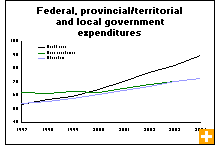Common menu bar links
Making health a priority
Archived Content
Information identified as archived is provided for reference, research or recordkeeping purposes. It is not subject to the Government of Canada Web Standards and has not been altered or updated since it was archived. Please contact us to request a format other than those available.
In the fall of 2004, Canadians were asked to identify the one issue that the government needed to focus on the most. By an overwhelming number, Canadians pointed to health care as the nation's number one priority. Health care was identified 46% of the time, followed by the economy and education at 7% and jobs at 4%. The public deficit and taxes registered at 2%.
Indeed, our health program has been a national priority since it was established in 1968. How the government spends our tax dollars reflects this. In 2004, all levels of government spent almost $90 billion on health services-about one out of every five dollars of expenditure. In comparison, $120 billion was spent on social services,$73 billion on education, and $39 billion on national defence, policing, firefighting and the justice system.
 A combination of factors, including the rising costs of medical
technology and Canada's aging population, have contributed to steady
increases in health services spending. Governments spent just over
$2,800 on health services for every man, woman and child in the country
in 2004, up from $1,800 in 1994. Most of the increase was in hospital
services and general medical care, which also account for the largest
share of health funding. Preventive care has generally accounted
for 5% or less of all health spending.
A combination of factors, including the rising costs of medical
technology and Canada's aging population, have contributed to steady
increases in health services spending. Governments spent just over
$2,800 on health services for every man, woman and child in the country
in 2004, up from $1,800 in 1994. Most of the increase was in hospital
services and general medical care, which also account for the largest
share of health funding. Preventive care has generally accounted
for 5% or less of all health spending.
More and more Canadians are using forms of alternative health care such as chiropractors, massage therapists and acupuncturists. In 2003, one in five Canadians aged 12 or older, or an estimated 5.4 million people, reported having used some type of alternative or complementary health care in the year before the survey.
However, because the costs of many types of alternative care are only partly covered by provincial programs, the use of such services rose with household income level.


